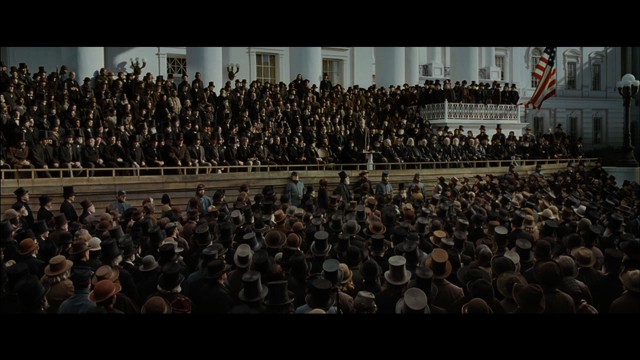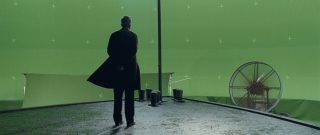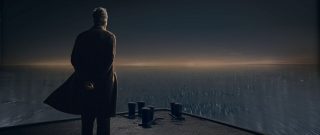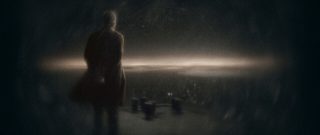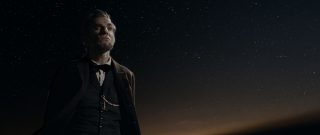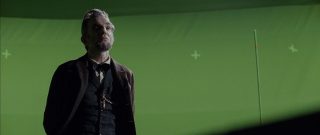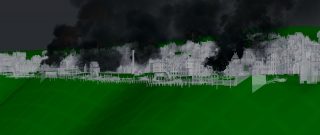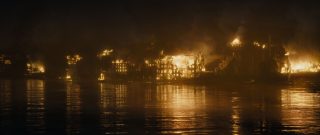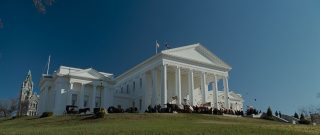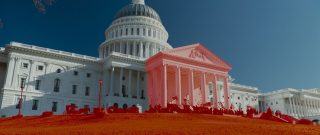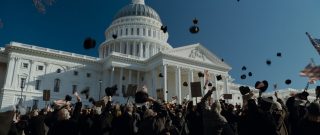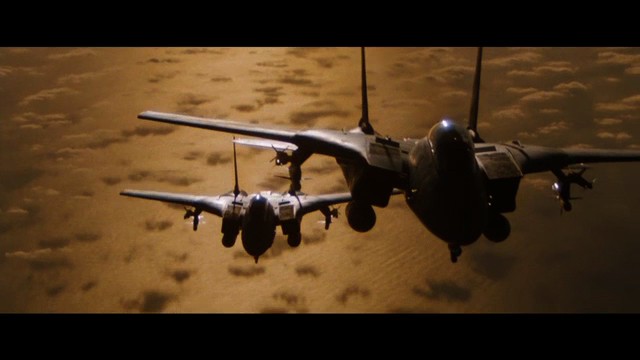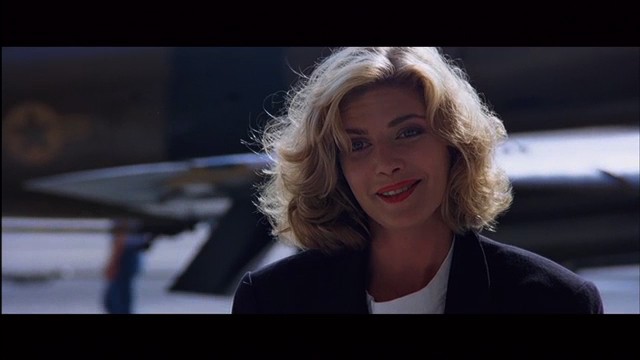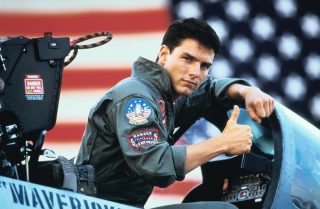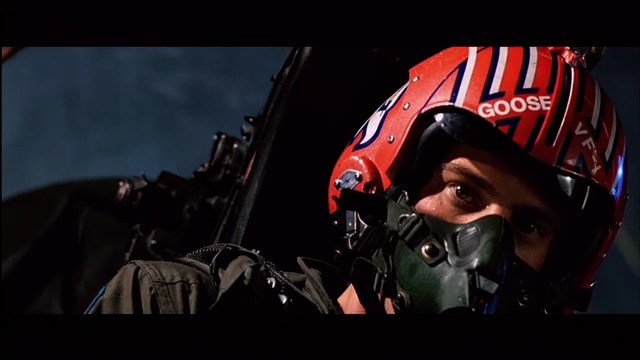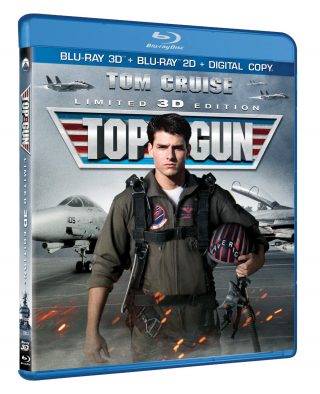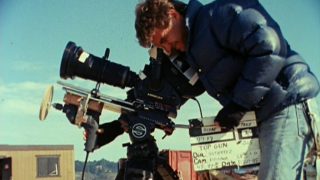When U.S. Navy SEALs raided a Pakistan compound on May 2nd, 2011 and
killed Osama bin Laden, it was an almost moonless night. So when
director Kathryn Bigelow sought to re-create the raid in
Zero Dark Thirty,
she and DOP Greig Fraser had a very clear mandate to film the scene in
almost pitch darkness. The result is an authentic re-telling of the hunt
for the Al Qaeda leader, but also one that posed a significant
challenge for the visual effects crew from Image Engine, called upon to
create photorealistic stealth helicopters used in the daring raid, as
well as several other key effects in the Oscar-nominated film.
Note: this article contains major plot spoilers
The helicopters – avoiding the game look
Two full-sized stealth helicopters were built in London for the film.
Initially, these were designed to be filmed on large gimbals for shots
of the SEALs traveling to the compound in Abbottabad, Pakistan and for
exterior views, where rotors and environments would be added.
Ultimately, due to changes in the action and lighting issues (discussed
below), most of the helicopter exteriors were achieved as Image Engine
creations.
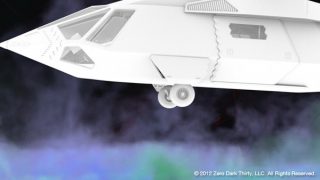
CG stealth helicopter and dust sim.
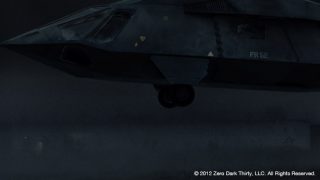
Final shot.
However, the stealth helicopter props were invaluable in providing
reference for Image Engine in designing and modeling CG versions. “They
were all CNC milled so we got the original 3D data for them which was a
huge jumping off point,” says visual effects supervisor Chris Harvey.
“Then it was a process of taking them and making them look real, with
dents, divots, scratches, grooves and bolts. We’d work on the lookdev
until you couldn’t tell the difference.”
One of the hardest aspects of the chopper design was that, by design,
they looked like game models. “They’re a few flat polygons with sharp
edges,” notes Harvey. “So they kind of look CG anyway – even the real
ones. Actually even Kathryn kind of called them ‘gamey’. They were
really sensitive to reflection angles. When the helicopter moved, it’d
be bright and the next time it’d be black. So we had to do some funky
curve reflections and some animated reflection cards that we’d track on,
just so they wouldn’t pop on with weird reflections.”
The dust effect
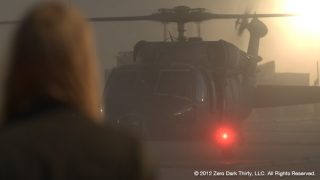
Original plate with stand in Black Hawk.
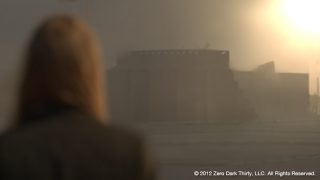
Clean plate.
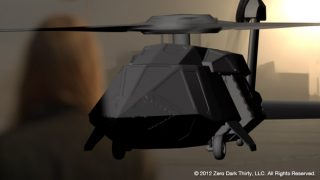
CG stealth helicopter.
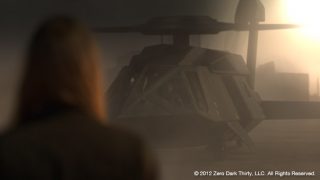
Final shot.
For scenes of the stealth helicopters taking off, landing, and later
for a crash sequence, Image Engine had another major challenge – dust.
But Harvey took the bold step of recommending to production that they
shoot real helicopters – Black Hawks – that would later be replaced with
the stealth versions. “Well, they straight away said, ‘What about the
dust?’ I basically said it was better to get real interaction with the
environment and we’ll replace what we have to replace.”
The visual effects team then had three main approaches to deal with dust:
1. In the case where a real helicopter created a performance that
Bigelow wanted exactly in the end, Image Engine match-moved the stand-in
and then substituted their digital stealth helicopter, embedded it into
the plate dust, and then added their own dust sims on top.
2. In other cases, the performance would be tweaked with the digital
helicopter. “The advantage of using the real helicopters was that you
got a whole bunch of nuances in the motion of the helicopter that would
have been really hard to get,” says Harvey. “And the dust interaction,
which was awesome, looked real because it was real, other than the stuff
we used to help integrate it.”
3. Finally, some shots would rely on throwing away any plate footage
and creating helicopter and dust shots from scratch, although of course
all the footage aided in animation and dust reference.
The digital dust was simulated in Houdini. “We built a helicopter
dust rig where we’d run a sim to create the rolling vortexes of the
dust,” explains Harvey. “We’d also add in any objects to the sim, like a
wall, so it would flow realistically.”
And dust turned out to be a crucial method used by Image Engine to
reveal the shape of the stealth helicopters, especially when they were
shrouded in darkness. “You couldn’t always shape it with say a rim
light,” says Harvey, “so we would try and choreograph the dust to reveal
the chopper almost as a silhouette. We ended up using non-lighting
techniques to add what you would typically do with the lighting anywhere
we could – against the sky or a bright part of the wall.”
In some shots there would also be pieces of debris, from paper to
styrofoam cups, pop cans and bottles, pieces of paper and plastic – also
simulated in Houdini. “So first there’d be a fluid sim for the dust
would be would used to drive a series of rigid-body geo, some cloth
objects and soft-bodies, depending on whether it was paper or cans,”
says Harvey.
Journey to Pakistan
After taking off from Afghanistan, the SEALs fly over the border to
Abbottabad in a series of shots made up of real aerial backgrounds
filmed over Lone Pine, CA, and Image Engine digital stealth helicopters.
Harvey lead the shoot using three Eurocopters through a number of
canyons and above varied terrain in the area. “We shot with real plates
rather than go all digital because it really helped provide something
authentic,” says Harvey. “It removed a lot of the guessing game and back
and forth of, ‘Well I think a real helicopter would bank here’. We
altered the animation a little bit because they were smaller
helicopters. We would track them and then dampen the animation curves so
they all seemed heavier.”
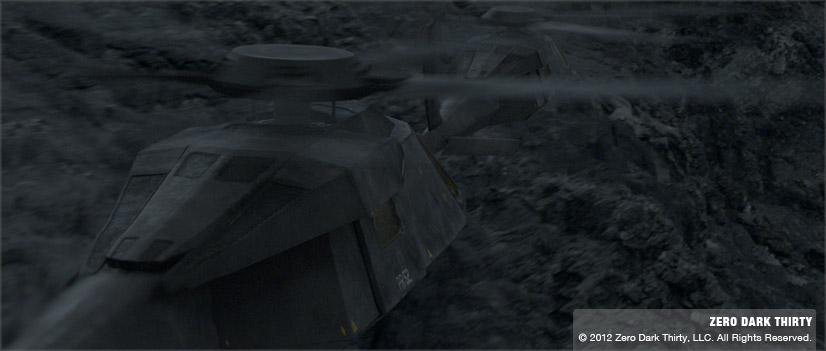
The helicopters travel over the border to Pakistan.
The Lone Pine plates were also filmed during the day. And that’s
where a further significant challenge lay for Image Engine – turning
these daytime shots into night. “In the end that involved a ton of work
from our comp team to re-grade all of the plates to look like they were
shot at night,” says Harvey.
Rotor blades on the digital helicopters were something the VFX supe
played close attention to. “We started with footage that had been shot
of the Black Hawks, then we took our CG model and we ran out a really
exhaustive series of wedges. We set our rig up so you could literally
enter in an RPM value for the rotors, then ran out a series of
side-by-side renders against the real footage, running at different
RPMs. We found the RPM setting that matched and that became the default
value that we plugged in.”
The compound
Day-for-night shots were also required for scenes of the SEALs
arriving at the compound. In Jordan, real Black Hawks standing in for
the digital stealth helicopters were filmed on a life-sized set
(designed with the help of Framestore concepts and 3D models) during a
narrow dusk window from 4pm to 5.30pm due to costs and safety concerns
of having to fly with night vision. “In some cases,” says Harvey, “you’d
have the sunset which gave you a fancy magic hour lighting conditions
that we’d have to go in and do sky replacements and re-grading and all
of that.”
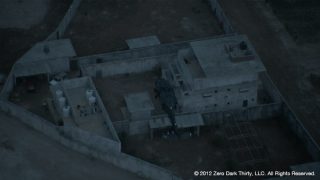
Original plate.
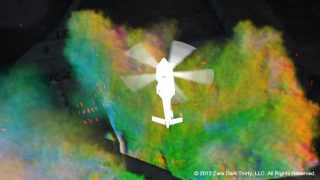
Dust sims.
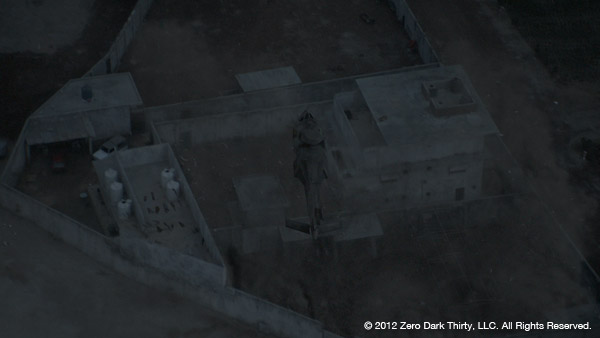
Final shot.
In addition, shooting during the day meant that there were no
suitable HDRs that could be taken. Image Engine artists were ultimately
required to tweak each helicopter shot on a per-shot basis. And even
then, once the DI process began, some shots required re-comping, as
Harvey explains:
“We would light everything a stop or two bright so we could bring it
down in the DI, but there needed to be a huge amount of collaboration
between us and the DI because there was such a narrow band of light
level that we had to work with. If we went a point to low, then once it
went through the print and a LUT went on it, everything just went black.
It was a very fine line. There was a bunch of shots we had to redo
because they just couldn’t hold up under projection environments. So at
the last minute we had to go in and re-grade and comp 25 shots just
because the margins were so thin.”
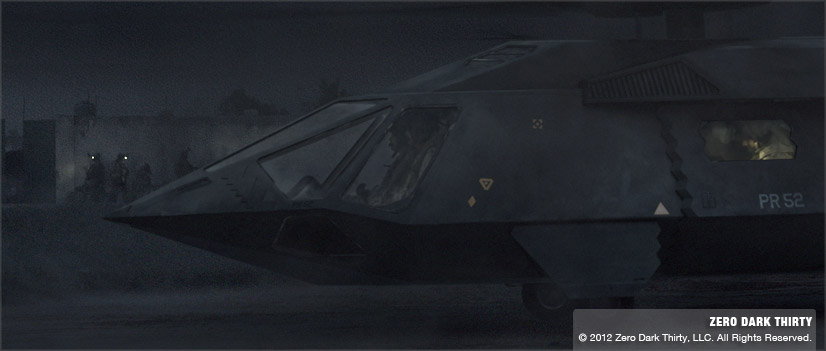
Outside the compound.
There are a few daytime shots of the compound, however, and these
included digital augmentations such as trees and surrounding mountains.
“At night we could get away with not adding them,” says Harvey,”
although we did add some distance lights. One of the days that we had
the Black Hawks there filming the crash and the take off, I just rode
back with them to the military base and we shot a whole bunch of aerial
night plates and city lights – 15 minutes of footage of random
flickering lights. Comp would just cut them out and piece them in back
in as lights for deep backgrounds.”
The crash
As one of the stealth helicopters hovers over a compound wall it is
caught in its own downwash before the pilot is able to bring it to the
ground. No one is injured, but the tail ends up resting on the wall. On
the Jordan set, the crash was filmed with the prop helicopter on a
crane. However, several factors resulted in Image Engine re-imagining
the sequence.
Firstly, the performance of the crane moving the prop helicopter was
deemed too slow. At the same time, some of the shots from the crash
sequence were re-choreographed because Bigelow and the filmmakers
received new information about what may have happened during the raid. A
third factor was related to the lighting response of the prop. “The
prop behaved a certain way in the lighting conditions on the set,”
explains Harvey. “It always looked a little too source-y for Kathryn,
like there was a moon somewhere, or that there was too big a hit. She
wanted everything to be always moonless, ambient, without a really
strong key or backlight.”
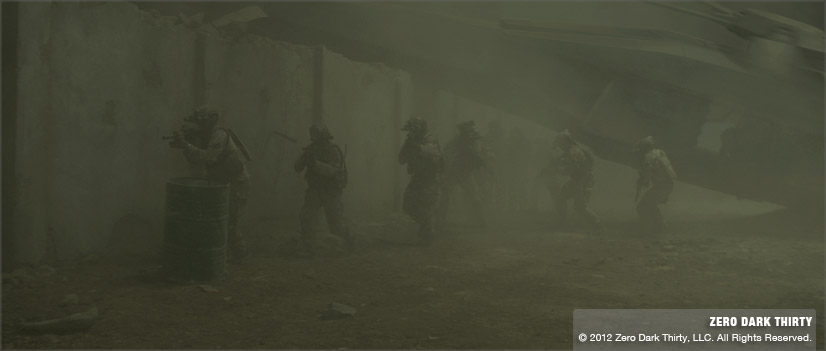
The SEALs leave the downed stealth helicopter.
This meant that Image Engine crafted the crash with a digital stealth
helicopter, and also completed other exterior scenes of the helicopters
at the compound that had originally been filmed with the prop. “We went
through hours of footage of what we shot there and we were looking for
plates that we could cut the rig out at a nice angle, and then we would
put our own performance in,” says Harvey. “We ended up constructing this
whole new sequence for Kathryn, and went through a couple of iterations
to get what she wanted.”
Bigelow’s request was for a ‘visceral, in-your-face moment’ as the
crash occurs. “A lot of that came through dust and debris thrown into
camera,” says Harvey. “When the tail goes onto the back wall, both of
those shots are entirely digital in the end. We animated the action,
which was cached out, given to the Houdini guys, and they would run a
rigid-body destruction simulation across the top of the wall and the
barbed wire to rip off the concrete and wire. That would be piped back
into the animation to deform and crumple the tail a little bit. Then all
that would be passed back into Maya for lighting and rendering. Then
dust sims were put on top of that. Then there would be piles of dirt and
sound and pebbles that got kicked up to make it in your face.”
Night vision
Peppered throughout the tense raid sequence are several night vision
point of view shots. To get these in-camera, DOP Greig Fraser bolted
night vision lenses onto the ARRI Alexas used for filming, and relied on
infrared lights. Occasionally, Image Engine was required to add a CG
element into one of these shots and so had to match the lenses. “There
were a few different ones used that had different scaling and noise on
them,” says Harvey. “So just like you would shoot lens grids, gray
balls, and gray charts to get your film grain with regular lenses, we
shot it again with all those lenses.”
Leaving the chopper behind
The mission, which was code-named Operation Neptune Spear, is a
success and bin Laden is killed and his body taken back to the Afghan
base. Before leaving, the SEALs destroy the downed stealth helicopter.
This was achieved as a practical explosion of one of the prop
stealths orchestrated by special effects supervisor Richard Stutsman
(who had previously worked with Bigelow on
The Hurt Locker).
“It was pretty awesome,” exclaims Harvey. “We’d been shooting for weeks
and we were right there on the edge of this little town and everyone was
always out checking things, especially this time because we had Black
Hawks flying around – it was also a little bit tense because we were a
mile away from the Dead Sea and right on the border of Israel.”
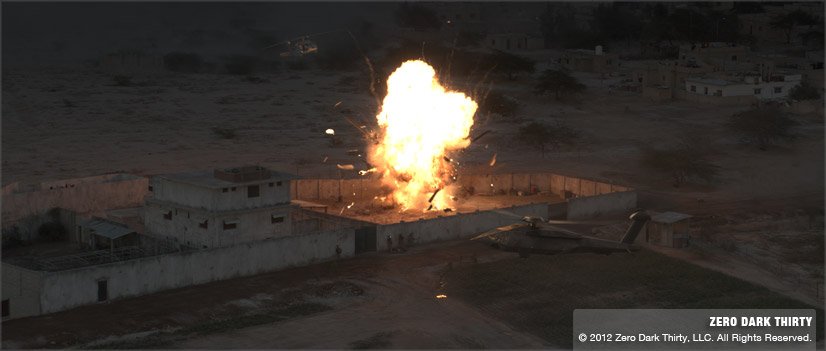
The downed stealth helicopter is blown up.
Image Engine made some slight augmentations to the final explosion
shot, replacing the initial view of the helicopter in the plate because
the prop had been cut up to fit the explosives in, and then adding some
flying rotors and debris, along with the remaining flying helicopters.
The shot was also given a night grade since it had been filmed at dusk.
Setting the scene
Of course, the compound raid sequence is the climax of the film – but
preceding this is the story of CIA agent Maya (Jessica Chastain) as she
attempts to zero in on bin Laden’s whereabouts. Image Engine completed
various visual effects for environments, military bases and several
bombings.
Explosion at Camp Chapman
Wide shots of military bases in Afghanistan, including one of Camp
Chapman, made use of reference photography and on-set elements. “We
would do a layout pass of each of the environments,” says Harvey, “and
that was with gray-shaded boxes and a quick matte painted paint-over.
And we’d get buy-off on building density, locations, cars. Then Kathryn
wouldn’t want to see it again until it was mostly done. The Chapman base
had 400 digi-doubles in the background, cars with dust in the
background – just to make it feel like a bustling base.”

Final shot just before the explosion.

The explosion at low angle.
It is at Chapman that a suicide bomber stalls the progress of Maya’s
search by killing her fellow agent Jessica and others in a car bombing.
The explosion is seen in two shots. Firstly, the low angle view has
smoke and debris filling the frame. For that, production shot several
different passes with multiple cameras – a clean plate, dust canon, an
air canon shooting into people, a fireball pass, a clean car and the car
blowing up. Richard Stutsman provided the practical explosion.
Image Engine then took those elements into comp and layered the shot.
“We did a little augmentation of the environment immediately around the
car,” adds Harvey. “In order to shoot all those passes takes a little
time so the sun would change position and the shadows would be falling
in different areas. So there was some 2D re-lighting of the shot. Then
down the street that’s all a matte painting extension.”
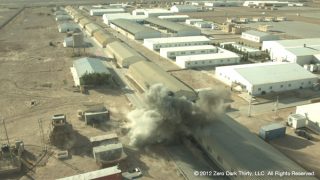
Original plate.
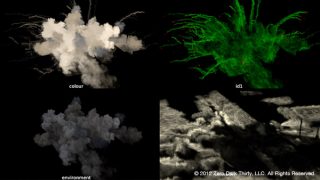
Houdini sims.
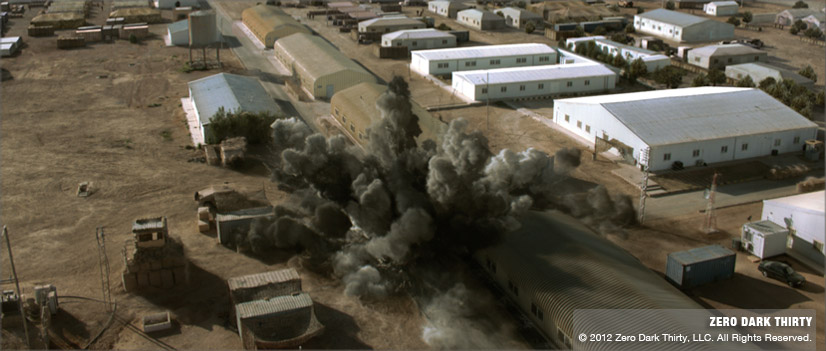
Final shot.
On the high and wide shot, the same passes were all filmed, but it
was decided the explosion needed to have more impact. Image Engine
replaced and matched the practical shot with a digital version created
in Houdini, also implementing shockwaves, shattering glass and
integration to the surrounding vehicles and buildings.
London and Islamabad bombings
In a late addition to Image Engine’s workload, the July 2005
terrorist attack on London is highlighted in a scene depicting the
explosion of a double-decker bus. Originally intended as just hinting at
the devastation, the explosion is shown more fully as the bus passes a
clump of trees. “We organized our own pyro shoot here on a stage and
blew some stuff up that we used for elements,” says Harvey. “Then from
some of those cameras from the Chapman explosion, we went in and cut out
stuff we could use. Then like a jigsaw puzzle we built up the explosion
that happens behind the hedge and the trees for the bus.”
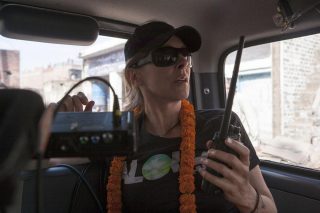
Director Kathryn Bigelow.
The 2008 Islamabad Marriott Hotel attack is also shown in the film,
with the bombing survived by Maya and Jessica as they dine in a hotel
restaurant. “Richard Stutsman did an amazing job on that explosion,”
notes Harvey. “We just had to do a fair amount of paint-outs – he had
pull wires on tables, chairs, people. We did a bit of augmentation in
terms of extra fill smoke and a little grading and some fire enhancement
to make it feel like there were some core flames. Then Kathryn got us
to make a couple of wine glasses and bottles fall over which hadn’t in
the blast – so we went in and painted out any remaining objects on the
tables that didn’t tip over. ”
Attention to detail
It was that attention to detail for shots such as the Islamabad
explosion that gave the film so much authenticity, according to Harvey.
“Kathryn has a really different eye for visual effects – she didn’t
dwell on stuff that people would expect, but we were doing some fine
work, going into crowd shots and changing the shape of turbans and other
small things, even changing the colors of people’s robes – no one will
ever know! We did a ton of stuff like that, but for Kathryn it was just
making it more authentic.”








